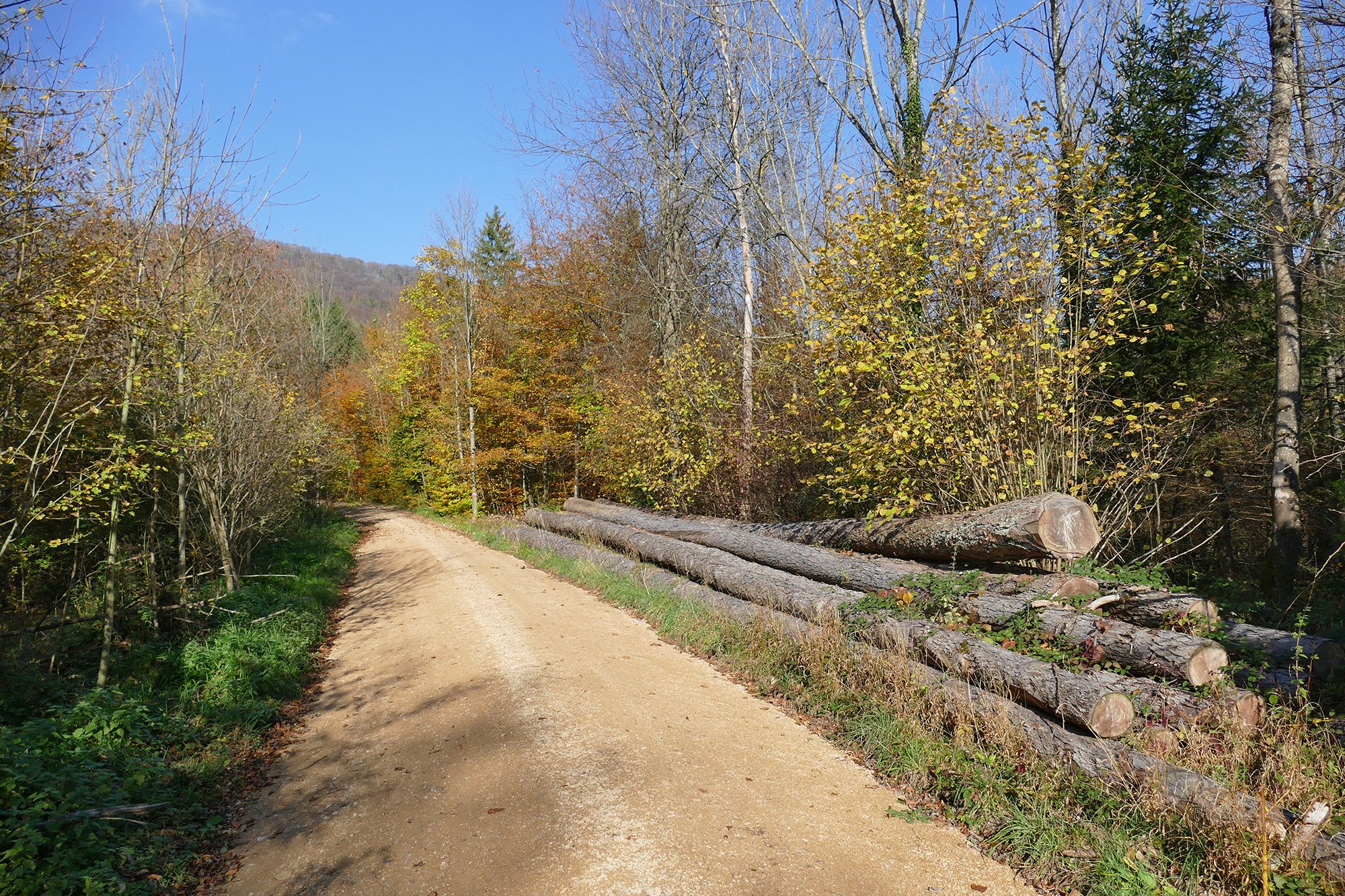Timber harvesting can cause an appreciable amount of bark damage. This requires comprehensive analysis to throw light on all the details. In particular, an analysis of the causes, as accurate as possible, is needed, in order to allow us to undertake specific countermeasures to improve the situation in the medium and long term at the operational level. The important thing here is to map throughout the year the current timber harvesting conditions with the high demand for raw wood and to take into account the use of modern forestry machinery and its integration into current normal procedures.
The proportion of trees with bark damage of all the trees remaining in the population after a harvesting operation is the central indicator for the conservation aspect of the timber harvesting measure. The many and varied influencing factors for bark damage are known from the relevant literature. Despite the many different national and international studies on the topic in the form of more or less specific case studies, integrated observations of the causal network of timber harvesting procedures and the resulting bark damage are scarcely to be found. It is at this point that the concept of the investigations by the FVA enters the stage.
Seven influencing factors are decisive
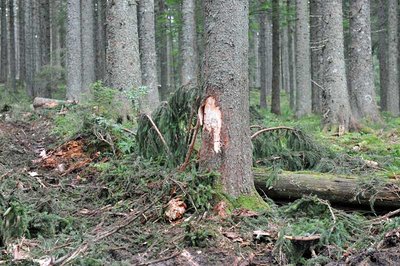
Bark damage caused by timber harvesting.
Our investigations and models were able to establish the following seven influencing factors in descending order of significance:
- The intensity of intervention has the strongest influence with a relative influence of 28%.
- The proximity of the tree to the skid line, logging trail, machine trail or rope-way is the second most significant influencing factor at 25%.
- The working techniques used, including the associated processing of short (up to 7 m length) and long (from 7 m length) lengths take third place (16%),
- followed by mean skidding distance (13%).
- The tree species has only a relatively minor influence (taken as a whole for the differentiated tree species in the analysis 12%);
- Spruce and beech emerge as the most sensitive tree species and fir, oak, Douglas fir, pine and larch are less affected.
- A further influencing quantity identified in the model is tree height (6%), from which only a weak influencing trend can be deduced.
For the factors, tree species and tree height, which were referred to last, the influences on the resulting damage percentage tend to be exaggerated in the models. Furthermore their order in the sequence changes, depending on the modelling method (Fig.1). The sequence of the most significant influence quantities illustrated is not surprising, and in fact supports the insights gained from individual studies at the national and international level.
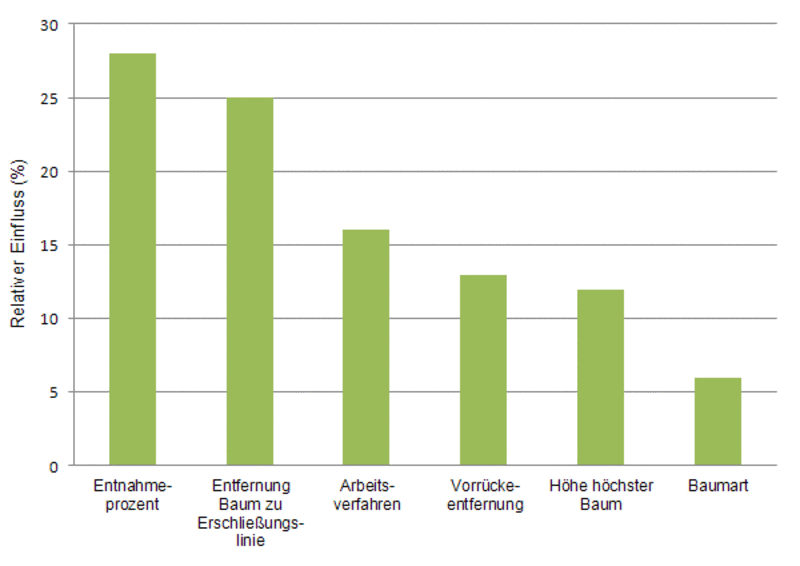
Fig. 1: Influencing factors for the appearance of bark damage due to timber harvesting in the order of their relative influence.
The influencing factor, distance of a tree from the skid line (Fig. 2) requires further clarification. As expected, the risk of suffering bark damage is greatest in direct proximity to the skid line. This risk reduces sharply at a distance of up to about 10 m and only starts to increase again until a distance of roughly 40 m is reached. This last may be due to the fact that as the distance from the skid line increases, it becomes impossible to control the forward movement of the felled trees and it is not always possible to compensate it satisfactorily by felling.
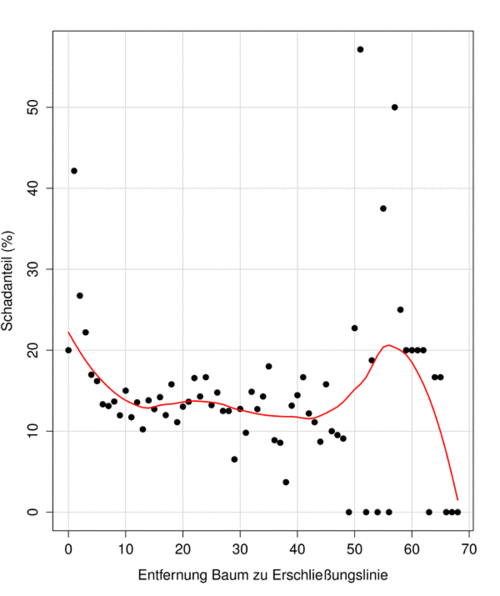
Fig. 2: Influence of the distance of damaged trees from the skid line in metres.
Timber harvesting procedures determine the amount of bark damage
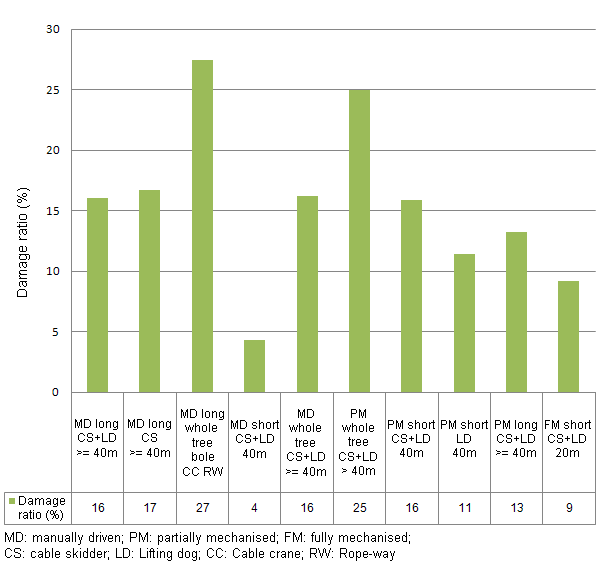
Fig. 3: Timber harvesting techniques in the 183 test harvests, grouped into 10 groups by degree of mechanisation, processing of shortwood/longwood/whole tree/bole and skidding equipment, identified by damage percentage.
The modelling highlights the factor of timber harvesting procedures as one of the single most influential effects on the amount of bark damage. It is worthwhile to examine this in more detail. Fig. 3 organises the timber harvesting procedures in the 183 harvests observed into 10 groups. The following conclusions may be drawn:
Harvesting timber using cable cranes and cable skidder with a simple winch without lifting dog emerges as more damaging than using such cranes with gripper arms or lifting dogs, which manipulate the logs with less damage through the remaining trees. In principle these technologies obviously become more significant where the conditions are more difficult (slopes, areas of natural regeneration). The results show that techniques with whole tree, bole and longwood hauling are those which tend to cause the greatest amount of bark damage. In particular, when these techniques are coupled with long skidding distances, they result in a high degree of bark damage. Conversely, techniques using short wood processing techniques cause significantly less damage.
Another fundamental aspect is the degree of mechanisation. The model calculations indicate that fully mechanised methods and those which are highly mechanised to a partial degree, that is, which use special forestry tractors with a crane and lifting dog for skidding, tend to conserve the environment more than those which make little use of technology.
The influence of the season on the degree of damage was observed only in the form of the extent of the damage, but not as a factor influencing the number of cases of bark damage due to timber harvesting. In this respect this factor does not appear in the diagram, but it does have high practical significance.
"Soft" factors difficult to identify
All in all, the models of the factors influencing bark damage due to timber harvesting classified 85% of the trees accurately; that is, it was accurately predicted whether they would show bark damage or would remain undamaged. The influencing factors listed as "measurable" and relevant in Fig. 1 have therefore acquired an overall explanatory potential of approx. 69% of the measured distribution. Accordingly, the "chance" effects similarly acquire explanatory potential of 31%. By virtue of the inclusion in the present study of all conceivable influencing parameters, which extend beyond those referred to above, but which have not been illustrated by reason of their small explanatory potential, it can be inferred that these random effects are attributable to "soft" factors, which are technically difficult to identify or not identifiable at all. These may lie at the operational level and point in particular to causes linked to management and to the workforce, such as organisation, training, professional knowledge, motivation and commitment.
